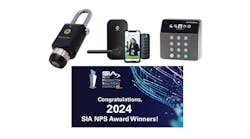TWENTY YEARS AGO
Jerry Levine visited several locksmith businesses to see what system different locksmiths used to arrange keys on their keyboards. Carl Dean outlined steps to take in determining if electronics access control is the best solution for a security problem. William Heine suggested biometrics as an advanced upgrade for a security system. Pat Olmstead, Von Duprin, had some pointers on selecting the correct door hardware product. Jerry Levine visited Proprietary Controls Systems Corp. (PCSC) to report on their Eclipse II access control system. T.C. Mickley offered a list of substitute key blanks which can be used if the correct key blank is not available. Several popular computerized code programs were compared. Louis George explained the job of an architectural hardware consultant. Tom Gillespie demonstrated the features of an 'under the window' tool for unlocking a Lexus SC400. Jerry Levine reported on an impending merger of the Abloy and Securitas groups. A listing was included for several new auto key blanks by Borkey. Where are they now? Locksmith Ledger printed a listing of 160 most popular vehicle key blanks. With the movement towards remotes, the list is probably much smaller today. James Glazier suggested CCTV as a new profit center for locksmiths. Ed Hite reviewed digital access control systems. Milt Wolferseder opened a Meilink insulated file safe.
TEN YEARS AGO
Impulse items were the topic of the August 2004 Locksmith Ledger. Jerry Levine suggested making use of open spaces in your store to display impulse items. Tom Gillespie visited several Midwestern locksmiths and took pictures of their impulse item displays. Gale Johnson reported on a tour of the Sargent factory in Connecticut. Jerry Levine assisted in the installation of a Securitron Magnalock at a school building. Gale Johnson visited an educational presentation staged by Markar. In addition to first-hand knowledge, every student received a bottle of Markar hot sauce for chicken wings. Tim O’Leary offered an overview on available exit alarm products. O’Leary also reported on the Kaba Peaks Global high security lock system. Jerry Levine wrote a historical account of the movement towards vehicle electronic locking systems. Locksmith Ledger cautioned readers to learn about building safety codes to avoid legal problems when installing hardware in commercial buildings. Ledger also reported on the procedures to use when opening a safe with a Kaba Mas electronic lock. Tiny serviced the locks on a 2004 Nissan Murano. Gale Johnson explained the reasons behind early failure of sidewinder locks.
A Look Back In Time
As Locksmith Ledger prepares to celebrate our 75th anniversary later this year, we are taking a look back through our files and re-posting some vintage articles and photos on our Facebook page. This particular photo was one of our favorites and is courtesy of Laurence “Laurie” Simon. It shows the giant key board and a row of locksmiths cutting keys at his family’s lockshop, S & S Key Service on the south side of Chicago, in approximately 1939.
The following in an excerpt from Laurie Simon’s article “A Day In The Life of a Locksmith; 1939,” which was published in our 65th Anniversary edition 10 years ago. Read the entire article online at www.locksmithledger.com/11567681.
Key cutting was a major source of income. Often, four to five locksmiths worked the front counter running three Keil automatics and other machines just to keep up with the customer traffic. Unlike today where only a few popular key blanks are needed, locks from all manufacturers such as Barrows, Clinton, Earle, Penn, Reading and Sager -- a few names from the past -- each required a specific key blank. An 8’ high by 24’ long keyboard was hand-built. Cylinder, bit, flat, barrel, railroad bronze, and other types of keys were grouped together. The upper section of the key board was devoted to precut original trunk, foot locker, bit & barrel keys that were identified by the number on the lock. Specialty keys like foreign lock keys were slower movers and were kept in the upper section
In a short time we found the main board wasn't enough. A second board placed in the very front of the store on the wall measured 6’ by 6’. This board was devoted to automobile keys from late models and cars long gone, such as Maxwells, Cords, Duesenbergs, Essex, Franklins and others that car buffs would recognize.
“Keys made while you hesitate” was our slogan.






